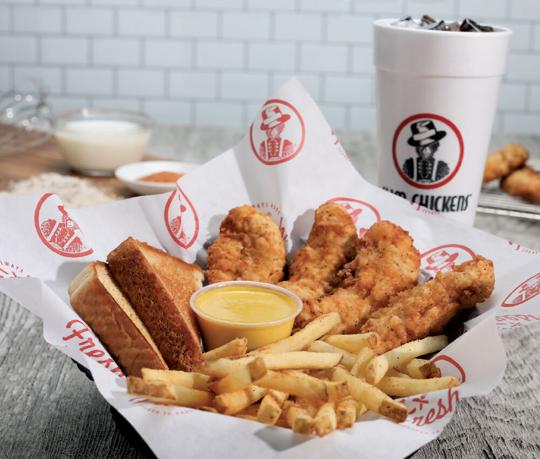2023 Fast & Serious Winners

January 4, 2023
#5 Slim Chickens
Fast-casual chicken restaurants
A lot has changed since Tom Gordon and Greg Smart co-founded their chicken chain in Fayetteville, Arkansas, in 2003, and then began franchising in 2013. System sales grew 118.7 percent from 2019 through 2021, to $265 million, and units grew 46.7 percent, to 132. But “there are a lot of things that are the same. I still feel so responsible for all 8,000 people that work for the brand,” said Gordon, CEO. “It’s nice to be in a position of financial strength versus scrambling for the first decade. That’s allowed us to do a lot of great things for our company, our franchisees.” Asked about his philosophy toward driving sustainable growth, he said, “It’s a big question. It’s hard to put that into a short motto. I’ll tell you a couple things I talk about all the time, with my team. Because we’re not as big as some of our competitors we have to go fast. We have to go as fast as we possibly can without taking big risks. And how do you balance speed and giant risk? It’s with using data, utilizing franchisee intel, utilizing local professionals” to put “great restaurants in great places as fast as we possibly can, and get market share.” A mobile loyalty app developed in 2019, coincidentally before COVID, paid off big time for the brand. A minority investment from 10 Point Capital in July 2019 helped shore up the balance sheet. But Slim Chickens’ biggest achievements go beyond single tactics. “Personally, we always think about how we want to be the franchisors the franchisees love, and not have an adversarial relationship, as so many end up having when the company’s been around a long time. Honesty and integrity are the only currencies we have,” Gordon said. “We’re proud of it. We’re proud of the perseverance we’ve shown. We’re proud that we have a great group of franchisees that I think are happy with the brand.”
#11 Walk-On’s Sports Bistreaux
Casual sports bars & restaurants
Getting buy-in to the Walk-On’s mission of bringing people together starts on day one, said CEO Brandon Landry, and being able to scale that mission across a growing system of restaurants is a main driver of growth. “Orientation, it’s the single most important day you can have,” he said. “Before we get into our Xs and Os, we tell our story. Before they put on an apron or start battering shrimp, they need to understand.” That story includes Walk-On’s founders Landry and Jack Warner walking on to the Louisiana State University basketball team and the “underdog mentality” they developed opening the first restaurant in 2003. Walk-On’s jumps nine spots on the Fast & Serious list with a three-year sales growth rate of 88.8 percent, from $134 million in 2019 to $253 million in 2021. It had unit growth of 93.9 percent during that span to hit 64 locations. “WOW moments”—aka the Walk-On’s Way—recognition cards are one way the brand keeps its culture visible. “We’re recognizing people for demonstrating a core value or guiding principle,” said Landry. “And we do it in front of the whole team. It’s all about just being a great human.” That translates to employee retention, and for restaurants with low turnover “it’s no coincidence that they’re at the top in terms of sales volume,” he said. In-store dining is back to pre-COVID levels, and Landry credited a focus on quality, inventive menu items for continuing to attract customers. Seventy-five percent of the sales mix is food. “We’re a restaurant, not a bar that happens to serve food,” he said. As online ordering and takeout sales grew through the pandemic, Walk-On’s reevaluated the size of its restaurants, which had an average footprint of 8,000 square feet. They’re rolling out a sub-6,000-square-foot prototype “and we’re still seeing the volumes where they need to be,” Landry said.
Share
Copyright © 2022 10 Point Capital | Atlanta, GA 30305
Disclosures Privacy Policy Terms of Use
Copyright © 2022 10 Point Capital
Atlanta, GA 30305
Disclosures
Privacy Policy
Terms of Use
Web Design by Studio Foray